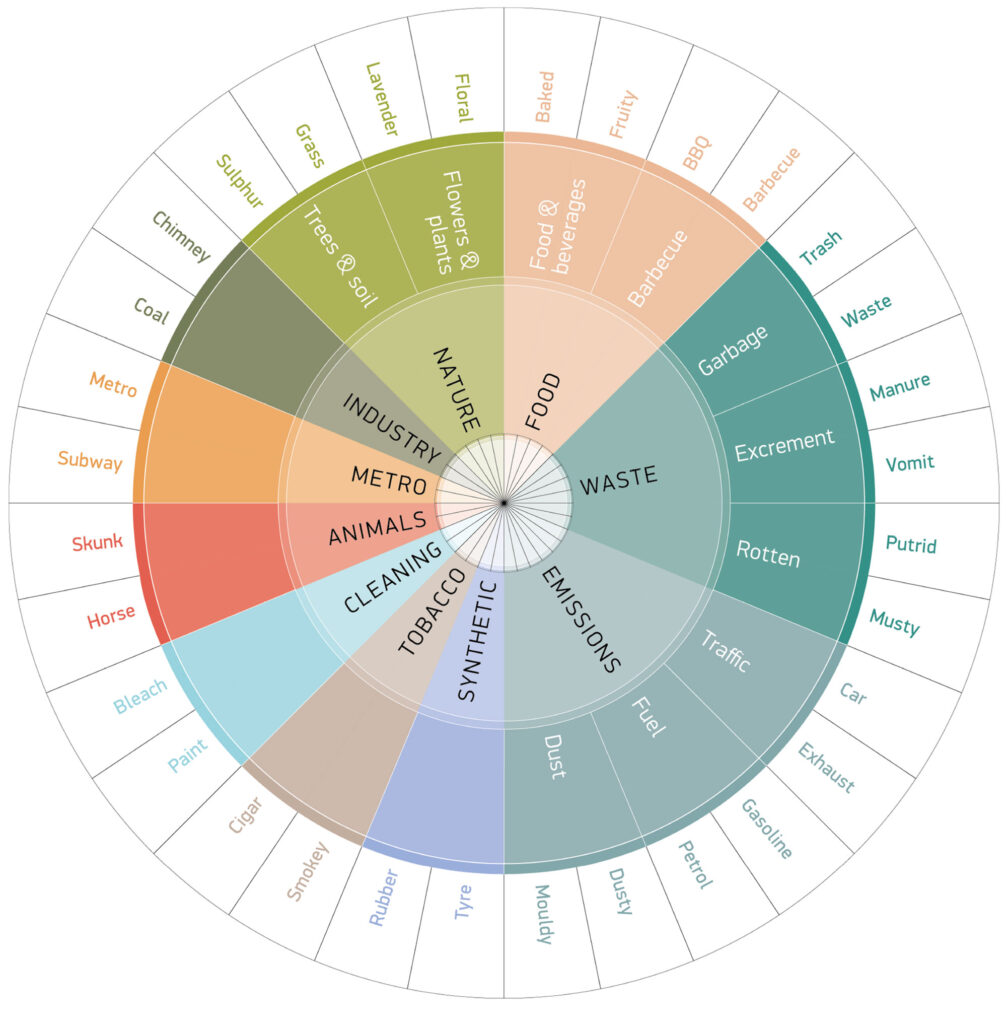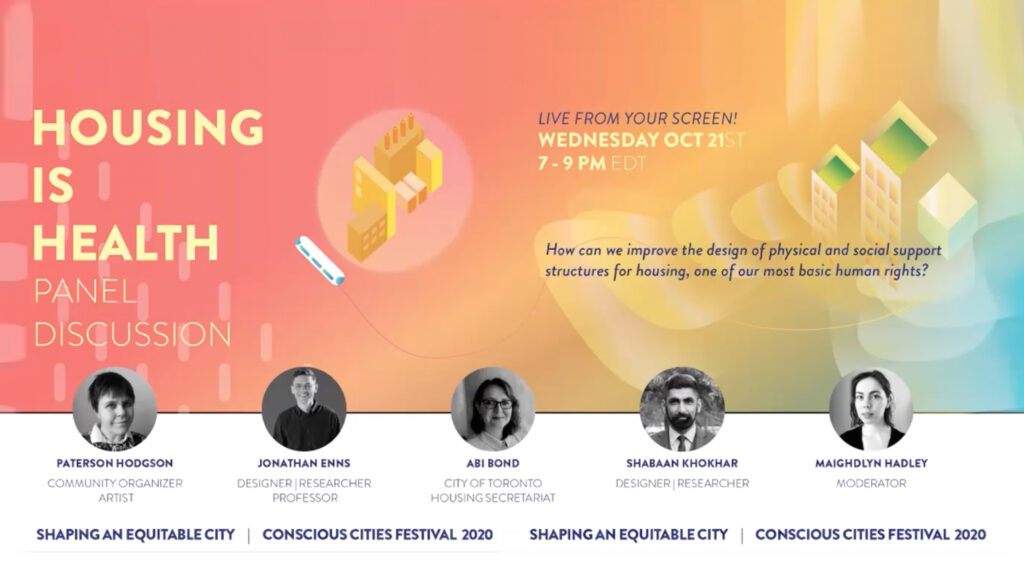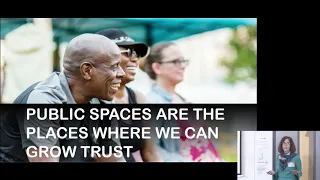Smell and the City
The link between smell and urban perception has long been underestimated (O’Meara & Majid, 2016; Kubartz, 2014; Quercia, Schifanella, Aiello, & McLean, 2015) because the visual aspects have been at the core of urban planning (Kubartz, 2014). Smell has typically only been considered for its negative effects on the city, such as the problem of sewage (Quercia et al., 2015; 2016). After centuries of focusing solely on the visual, urban planners are now becoming increasingly concerned with the smell of the city. Researchers realize that the city is not only based on what is visible to the eye, but also on other invisible elements. Thus, tracing these significative elements of the city requires additional methods and procedures (Daniilidis, 2016).
Previous research has illustrated that people are able to detect up to one trillion smells (Bushdid et al., cited in Quercia et al., 2015). Moreover, according to Rose Eveleth, the sense of smell is the first sense humans use from the moment of birth (TED, 2013). Other research has confirmed that people use smell to record their perception of places in their long-term memory (Quercia et al., 2015). This enables them to categorize high or low socio-economic lifestyles and to set their expectations within a specific city accordingly (Borer, 2013; Dzhambov & Dimitrova, 2014).
Case Studies
Quantitatively measuring the effects of smells on people’s experiences can be very difficult. The use of olfactometers (used to detect odor molecules) and online participatory mapping to record odors (Quercia et al., 2015) are not suitable methods, owing to a lack of participation, and their limitations of use in specific areas or places. Alternatively, documenting people’s experiences and memories could be through “smellwalking”. This term is used by the researchers studying the link between the smell of a space and its representation to people passing by or living in it. Smellwalking a data recording method consisting on the conscious expression of the participant walking around a pre-planned route of specific natural and built environments. Based on their “olfactory experiences and memories of space and place” (Kubartz, 2014, p.100), the participants could express what the space they are walking in represents to them and to what extend it affects their wellbeing or trigger certain emotions. It could create interesting, although still clearly limited, qualitative data because it is limited to the context and the individual and collective memories (Quercia et al., 2015).
Hence, the discussion examines two different methods of data collection used in three different cities. The first study utilizes semi-structured interviews, whilst the second relies on smellwalking and documentation that generates a scientific categorization system of smell-related words.
Study 1: Krakow, Poland
In a study conducted in 2012, researchers Sliwa and Riach interviewed 30 inhabitants of the city of Krakow. The participants had lived in Krakow all their lives and had memories of the transition of the city that occurred in 1989. Results are based on “Classen et al.’s (1994) concepts of “olfactory classifications” and “dynamics of smell”, which emerged from studies of smell in the indigenous cultures of Africa, Oceania, and South America such as “the use of smell to define place” (Sliwa & Riach, 2012, p.29). Their results revealed the role played by the smell in the city. The smell is not inherently the object of approval or disapproval; rather it is its relation to the component of a city and the lifestyle that are important. For example, the participants of this study acknowledged their satisfaction of transition from socialism to capitalism through remembering the smell of their neighbor’s cuisine. According to their accounts, the smell showed them the degree to which they lacked privacy in the socialist flats they had to live in at the time. Smell was labeled as intrusive; a socio-political description. Moreover, their description of smells translated their urban and socio- economic expectations into a fact. For example, they classified girls into those who had deodorant and those who collected empty perfume bottles, because, for Kracovians, it was a criterion of separation between the bourgeoisie and the working class (Sliwa & Riach, 2012). They also presented a pleasant smell as a symbol of development (Sliwa & Riach, 2012).
Study 2: Barcelona and London
During 2015 and 2016, Quercia et al. studied seven cities in the UK, USA, and Europe. Here, we will discuss the specific cases of Barcelona and London. In these two studies, researchers matched social media tags (Instagram, Twitter, and Flickr) with dictionary words related to smell. Next, they asked local residents to walk on predetermined routes, stopping to take notes when they discern significative smells. They discovered that these words can be classified into 10 categories, as described in Fig. 1. This was developed into the first urban smell dictionary. Furthermore, the results revealed that while there are dominant smells, there are also local smells that create local references (Quercia et al., 2015; 2016).

From the study in 2015, researchers were able to demonstrate the following:
- London became a “clone town” where the urban individuality is lost in the globalisation trend, resulting in a smell similar to many other cities (Quercia et al., 2015).
- The city’s quality of air, polluted with chemicals such as carbon monoxide, is a result of human activities affecting human wellbeing (Quercia et al.,
2015). - Smells of waste and smoking are concentrated in the evening economy clusters where odours of urine and cigarettes are more concentrated (Quercia et al., 2015).
- Smells of cleaning products are concentrated around hospitals, industrial areas, and railway stations (Quercia et al., 2015).
In 2016, researchers found out the following:
- When they asked participants to match what they are smelling with a colour, these participants identified some places of reference by defined colours such as
black and red for the traffic, most probably because people were seeing the colours of smoke, roads, buses, and red lights (Quercia et al., 2016). - The most pleasant olfactory experiences in London are associated with the smell of the soil, especially near Trafalgar Square, Russel Square, and St James’ Park, whilst those in Barcelona are associated with food smells, especially in the city-centre main food market La Boqueria (Quercia et al., 2016).
- Pleasant olfactory experiences in the city can be categorised by seasons and months. For example, according to social media tags and 10-year statistics, the best smelling month of the year is May (Quercia et al., 2016).
- Smells are described using either positive or negative words. Positive words are usually associated with nature (such as grassy) and food (such as chocolate), while negative words are associated with waste and metro (Quercia et al., 2016).
Developing Smellscapes in Cities
“Smell creates highly emotive reactions and connections with space and place” (Dann & Jacobsen, cited in Sliwa & Riach, 2012). Therefore, the smell of a city should be adjusted, not only for instant enjoyment, but also for emotionally positive experiences and a sense of place. Based on the findings of the analyzed case studies1, this aim could be achieved by working on the smells of nature and food, matching them with seasons and colors of the natural and built environment.
More advanced methods to facilitate change might include materializing and concretizing the cityscape to mitigate the negative effect of smell on the perception of space and human wellbeing. This would require architects and urban planners to utilize neuro-architecture by cooperating with neuroscientists who measure the effects on people through brain imaging showing the areas affected by iconic smells of a specific city with which the participant has emotional bonds.
Data could be further enriched, using the “urban drifting.” Suggested by Alexandros Daniilidis, this concept is about having participants who walk without a determined route map in urban environments while recording, drawing, or writing down their experiences.
The next challenge would be in embracing people from different backgrounds coming to a specific city. Being able to control and merge specific smells intelligently would enable the creation of the iconic smell of the city that is pleasant for the entire spectrum of inhabitants.
References
Borer, M. I. (2013). Being in the city: the sociology of urban experiences. Sociology Compass, 7(11), 965–983. DOI: 10.1111/soc4.12085
Daniilidisa, A. (2016). Urban drifting: an approach to city comprehension and mapping. Sociology Study, 6(7), 417-435. DOI: 10.17265/2159 -5526/2016.07.001
Dzhambov, A. M., & Dimitrova, D. D. (2014). Urban green spaces’ effectiveness as a psychological buffer for the negative health impact of noise pollution: a systematic review. Noise Health, 16(70), 157-165. DOI: 10.4103/1463-1741.134916
Kubartz, B. (2014). Urban smellscapes: understanding and designing city smell environments. The AAG Review of Books, 2(3), 99-101. DOI: 10.1080/2325548X.2014.919152
Nordqvist, C. (2018, February 16). What are pheromones and do humans have them? Medical News Today. Retrieved from: https://www.medicalnewstoday.com/articles/232635.php
O’Meara, C., & Majid, A. (2016). How changing lifestyles impact Seri smellscapes and smell language. Anthropological Linguistics, 58(2), 107-131. DOI: 10.1353/anl.2016.0024
Oriol P. (2006, September 26). Smelly City. Sustainable Rotterdam. Retrieved from: http://sustainablerotterdam.blogspot.com/2006/09/smelly-city.html
Quercia, D., Aiello, L. M., & Schifanella, R. (2016). The emotional and chromatic layers of urban smells. International AAAI Conference on Web and Social Media, North America, 309-318. Retrieved from: https://www.aaai.org/ocs/index.php/ICWSM/ICWSM16/paper/view/13092/12750.
Quercia, D., Schifanella, R. ̧ Aiello, L. M. ̧ & McLean, K. (2015). Smelly Maps: The Digital Life of Urban Smellscapes. International AAAI Conference on Web and Social Media, North America. Retrieved from: https://www.aaai.org/ocs/index.php/ICWSM/ICWSM15/paper/view/10572/10516
Sliwa, M., & Riach, K. (2012). Making scents of transition: smellscapes and the everyday in ‘old’ and ‘new’ urban
Poland. Urban Studies, 49(1), 23–41. DOI: 10.1177/0042098011399596
TED. (2013, December 19). Rose Eveleth: How do we smell? [Video File]. Retrieved from: https://www.youtube.com/watch?v=snJnO6OpjCs,
2013








